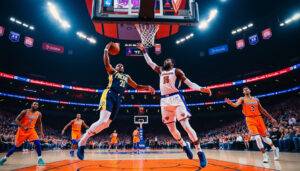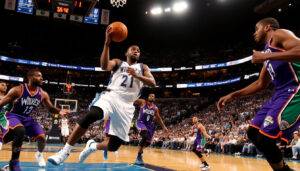Analyzing the NBA mock draft after the combine: who boosted their prospects and who could head back to college?
The 2025 NBA Draft Combine has come and gone, spotlighting promising talent and reshaping the draft lottery landscape. The process revealed a few standouts who elevated their stock considerably, while others hover on the fence, mulling over a return to college in a bid to sharpen their game and improve their draft positioning. With underclassmen deadline looming, the aftershocks of the Combine will determine who ascends to the professional ranks this June and who hits the pause button for another college campaign.
Top NBA Draft Combine Performers Who Elevated Their Draft Prospects
The Combine's intense drills and interviews offered a critical stage for prospects to showcase physical readiness, basketball IQ, and poise under pressure. A handful of players maximized their opportunity, improving their position on draft boards through dynamic displays of skill and athleticism.
- Cooper Flagg (Duke) remains the top lottery pick for the Dallas Mavericks, dominating across multiple stats and displaying versatility on both ends. His blend of size, footwork, and leadership propelled Duke to an ACC double crown and a Final Four berth.
- Dylan Harper (Rutgers), projected to land with the San Antonio Spurs at number two, impressed with his length and playmaking prowess as a lefty shooter capable of handling the point or playing off the ball.
- Ace Bailey (Rutgers) combines athleticism, scoring, and defensive tenacity, carving out a solid first-round spot with the Philadelphia 76ers.
- VJ Edgecombe (Baylor) and Tre Johnson (Texas) also caught attention with their athleticism and shooting, landing in prime lottery positions for the Hornets and Jazz respectively.
These prospects capitalized on their Combine performances by sharpening their narratives with scouts who prioritize readiness and upside in today's NBA game. For more on how Cooper Flagg's dominance at both the college and Combine levels strengthens his draft case, check our detailed analysis on NBA draft lottery and Flagg prospects.
Influences Behind Draft Stock Changes Post-Combine
The NBA draft process doesn't stop at the Combine. Prospects now face private workouts and pro days which are critical for final evaluations. The geographic spread of these sessions creates individualized paths for players to appeal to specific teams based on tailored needs.
- Physical Measurements and Athletic Testing: A major factor for scouts assessing immediate NBA readiness, especially for players with questionable college production.
- Interviews and Psychological Assessments: Teams scout intangible qualities like coachability, mental toughness, and professionalism.
- On-Court Drills and Scrimmages: Demonstrations of dribbling, shooting, passing, and defensive awareness.
While some talents solidified their first-round status, others like Alex Condon of Florida and Tahaad Pettiford of Auburn remain undecided, signaling potential returns to college to refine skills and enhance their drafts. This strategic deliberation is key in player development before making the leap to professional basketball.
Should Underclassmen Return to College or Declare for the NBA Draft?
The NCAA deadline of May 28 to withdraw from the draft and retain eligibility introduced a competitive tension amongst prospects. While declaring early suggests confidence, the potential for additional college development and exposure could grow long-term career value.
- Consider Returning to College: Players with raw talent but inconsistent production might benefit from an additional year of high-level college basketball under skilled coaching staff.
- Declare for the Draft: Those who showcased readiness through Combine testing and gameplay, improving draft stock sufficiently to secure a favorable position.
- Analyze Market Demand: Agents and scouts advise prospects based on organizational needs and the depth of positional talent in the draft class.
For example, Puerto Rican forward Yaxel Lendeborg from UAB entertains a Michigan return, weighing the merits of another collegiate season that might polish his shooting and defense. Their decisions resonate beyond personal career paths; they impact recruitment and talent evaluation frameworks for college programs and NBA teams alike.
Players Who Improved But Still Face Tough Draft Decisions
Several noteworthy freshmen and sophomores exhibited significant growth but remain borderline first-round candidates due to positional logjams or need for enhanced consistency.
- Kasparas Jakucionis (Illinois) - A playmaker with scoring and passing ability but turnover concerns linger, especially after end-of-season shooting struggles.
- Kon Knueppel (Duke) - Efficient shooter stepping up with key performances, yet depth at wing threatens draft status.
- Collin Murray-Boyles (South Carolina) - Versatile forward with strong rebounding and finishing but compensates for undersize.
- Derik Queen (Maryland) - Skilled big man blending power and finesse, potential stretch big with further skill honing needed.
These players epitomize the nuanced nature of the draft, where raw talent intersects with readiness and projection. The Combine and subsequent evaluations will finalize who jumps into the league and who opts for further refinement in collegiate basketball.
The Role of NBA Scouting and Recruitment in the Post-Combine Era
In the era of data-driven decision-making, scouting departments must balance quantitative metrics with observational acumen gained from the Combine, private workouts, and college performance analysis. Efforts center on predicting the developmental trajectory of players rather than mere current production.
- Player Development Projections: Teams estimate how a prospect’s skill set and athletic tools translate to NBA success, prioritizing adaptability and growth potential.
- Tailored Recruitment Strategies: Based on team needs and playing style, clubs target specific skill sets to construct balanced rosters.
- International & Overseas Scouts: Increasingly vital as players like Hugo Gonzalez (Real Madrid) and Noah Penda (France) make themselves known, expanding the talent pool beyond U.S. college ranks.
With the draft lottery influencing selection order — highlighted in the recent Mavericks 2025 NBA draft lottery win — scouting continues to be a chess game where understanding prospect trajectories post-Combine is crucial. The process culminates in informed choices that shape franchises for seasons to come.

